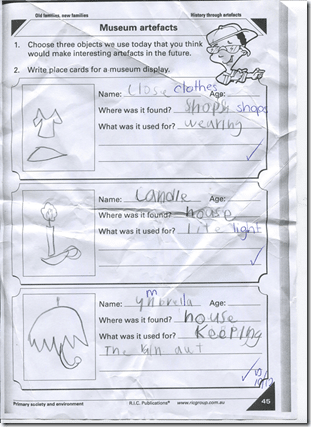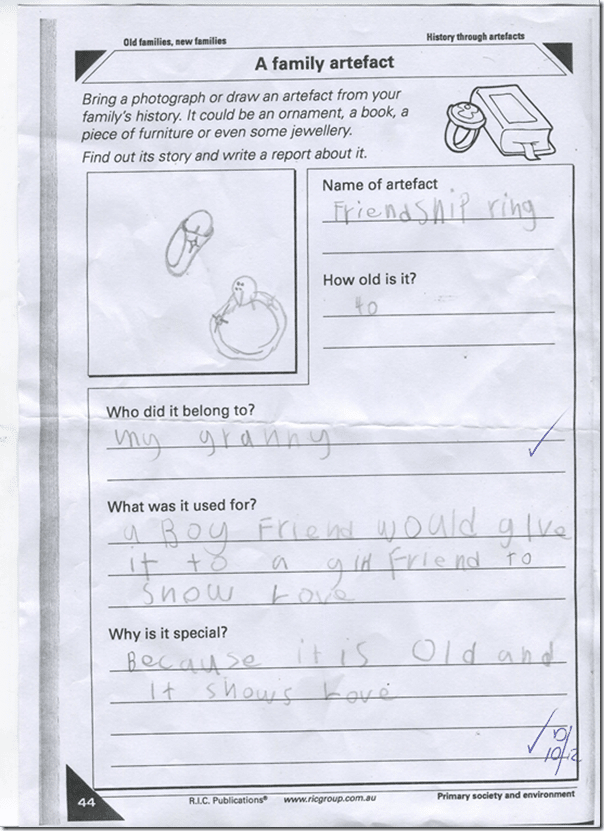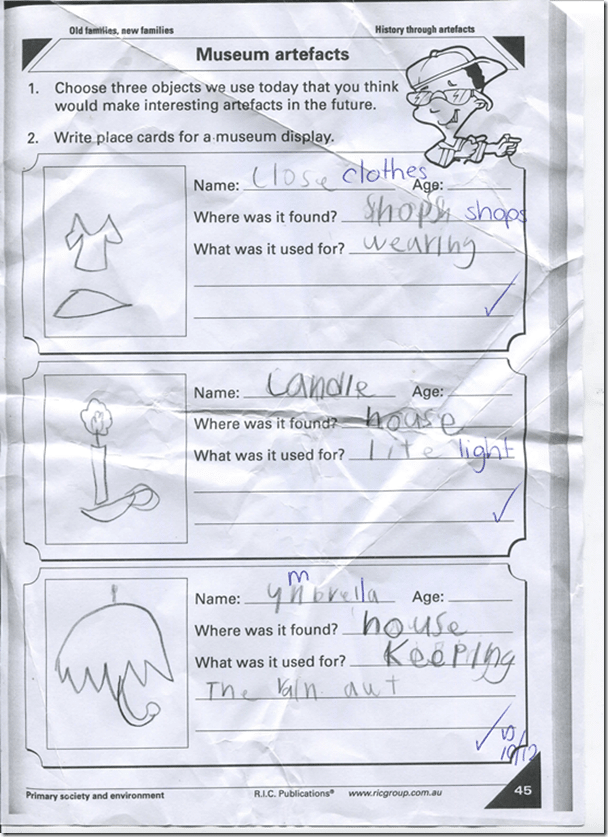Originally posted on December 15, 2014 @ 9:33 AM
Grade One Lessons in Culture
 I picked up my granddaughter from school the other day and she showed me her work and it was delightful to see what they have been doing in Grade One in Primary School on culture. What a shame we don’t do such work with people in risk and safety. Instead, safety seems to be preoccupied with behaviours-as-culture and the fixation with measurement. There’s no doubt about it safety, it loves lower order goals and the nonsense of ‘if you can’t measure it, you can’t manage it’. Not the case in Grade One Primary School. Here they are taught that everything has significance especially artefacts, text, language and symbols. I scanned my gradaughter’s worksheets and have attached them below.
I picked up my granddaughter from school the other day and she showed me her work and it was delightful to see what they have been doing in Grade One in Primary School on culture. What a shame we don’t do such work with people in risk and safety. Instead, safety seems to be preoccupied with behaviours-as-culture and the fixation with measurement. There’s no doubt about it safety, it loves lower order goals and the nonsense of ‘if you can’t measure it, you can’t manage it’. Not the case in Grade One Primary School. Here they are taught that everything has significance especially artefacts, text, language and symbols. I scanned my gradaughter’s worksheets and have attached them below.
Artefacts are so important in culture not just for what they represent and communicate. Artefacts influence values, decision making and judgments. Artefacts penetrate the unconscious in amazing ways which is why we can all draw a McDonalds sign or recall the slogan for Nike. An artefact can be a symbol or a text as symbol, this is the nature of semiotics. There is much more to a word than just what it represents, it embodies a history of meaning and a social psychological force that has political power. Just try and remove an artefact in a church or any other institution and discover just how much power that symbol or word has. Perhaps try and remove the word ‘zero’ from a ‘zero organization’ and find out just how much religious value that artifact has been given.
So why is it that children in Grade One Primary School do cultural studies and people in risk and safety know so little about culture, even though they talk about it constantly?
Risk and safety has a history and evolution emerging from mechanical, legal, regulatory, scientific and an engineering approach to anthropology. The risk and safety tradition understands itself as a mechanistic process. Risk and safety understands itself as those who ‘protect the Act’ rather than those who ‘develop relationships with people’. This is evident in the language of safety where even recently people laud the language of ‘resilience engineering’ (https://safetyrisk.net/cultivating-resilience/) or use militaristic language as a metaphor for conducting safety leadership (https://safetyrisk.net/who-is-the-enemy-and-what-war-is-safety-fighting/). In this tradition the human serves a system rather than a system serves the human.
The words we chose to understand ourselves in risk and have meaning, they are chosen with purpose and define that purpose. The language we use transmits our understanding of political power and the way we understand humans and relationships.
The artefacts of risk and safety organisations tell us a great deal about how humans are valued and how that organization understands risk and learning. Words as symbols have enormous social psychological power and those who believe that words are ‘just semantics’ ignore all the evidence that shows that words-as-artefacts unconsciously influence all we do. The repetition of words, signs and symbols that devalue a person or child very soon enables the dehumanization of that person. This is why those in battle zones must use derogatory names for the humans they are about to kill, this is the foundation of racism. The first step in alienating connection to another person and dehumanizing another person is name calling. Just have a look at how discussions turn to arguments on Linkedin, someone attacks and idea and pretty soon the other defends by attacking the person. Once the names are normalized in a culture (through the media spin of politics) eg. ‘raghead’, ‘cue jumper’, ‘nigger’, ‘bitch’, ‘idiot’ etc. we can pretty much do what we like to ‘the other’. Language is the foundation stone for cultural discrimination and prejudice. So why doesn’t safety understand the deficit influence of absolute and perfectionist words like ‘zero’? Once you break zero, I can do whatever I like to you, after all, if you don’t believe in zero you must want to hurt people. The symbol of zero has become the new sacred artifact of culture. The absolute of zero justifies the absolute in behavior, you deserve what you are about to get, you ‘zero breaker’.
I read many articles and aphorisms on social media purporting to be telling about safety leadership but they rarely discuss the power of words, influencing language or the unconscious power of symbols. It seems that Cultural Studies are devalued in safety, engineering and regulation are supreme. It seems that safety believes an artefact doesn’t really hold power in itself, it’s just a sign for something else. Zero is just a word, what are you getting excited about? Strange, wars have been started for less. Just try and touch something in a mosque, synagogue, temple or cathedral and find out about the power of symbols. And now in the cathedral of safety ‘zero’ has become the icon and challengers the ‘infidels’.
If I had my way in safety training I’d be getting out those Grade One Primary School worksheets and learning about culture well before I introduced anyone to the Act or Regulation.





Do you have any thoughts? Please share them below